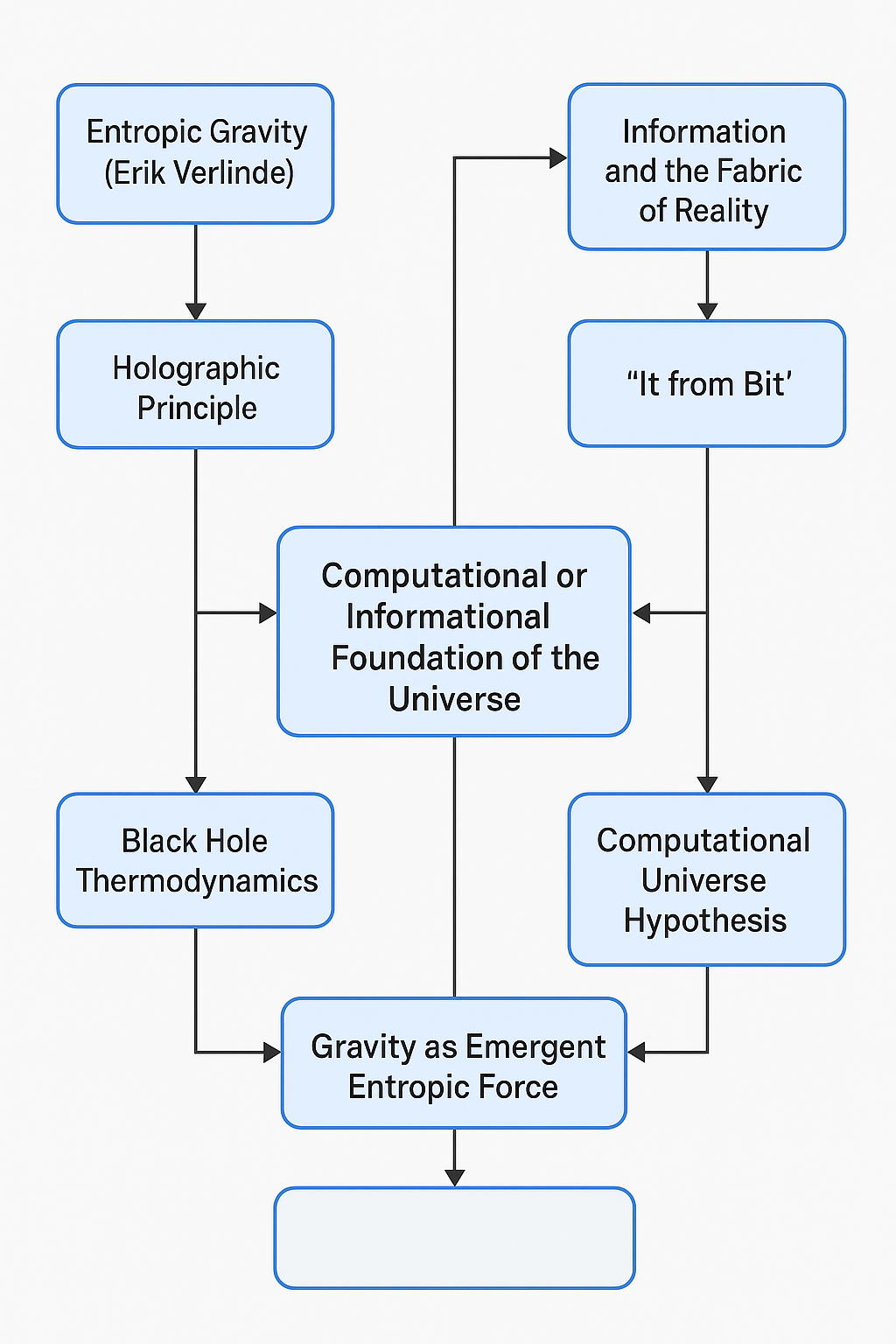The Universe as an Emergent Computational Simulation: Gravity, Entropy, and Information
In recent years, a convergence of ideas from physics, information theory, and philosophy has led to a radical hypothesis: the universe might be a kind of simulation—a computational construct where what we perceive as fundamental forces, such as gravity, emerge from deeper principles of information and entropy. This article aims to explore how gravity might not be a fundamental force but an emergent entropic phenomenon rooted in the second law of infodynamics and the equivalence of mass–energy–information.
Entropy and Information: Foundational Concepts
Entropy, originally a thermodynamic quantity, has been reinterpreted as a measure of information. In information theory, entropy quantifies uncertainty—the more uncertainty, the more entropy. Conversely, more information reduces entropy. This interplay becomes profound when we treat physical systems not just as collections of particles, but as carriers and processors of information.
The second law of thermodynamics tells us that entropy in a closed system tends to increase. In information theory, this suggests that the universe naturally evolves toward states of higher informational complexity. This law appears to be not just a constraint, but a generative principle: it drives the irreversible evolution of physical systems, encoding time’s arrow and the formation of complex structures.
The second law of infodynamics—a concept that extends classical thermodynamic reasoning into information space—asserts that the flow of information and the rise of informational entropy is a fundamental dynamic of the universe. Under this view, spacetime itself could be a product of informational processing, with forces like gravity being emergent behaviors in this system.

Gravity as an Emergent Phenomenon
Physicist Erik Verlinde proposed that gravity is not a fundamental force but an emergent entropic force. According to Verlinde, gravity arises from changes in information associated with the positions of material bodies. When an object moves through space, the information encoded on a holographic screen (imagined as a boundary encoding the system’s degrees of freedom) changes, resulting in a force we interpret as gravity.
This idea is supported by parallels between gravity and thermodynamics. The laws of black hole thermodynamics, for instance, reveal a deep relationship between gravitational systems and entropy. The famous Bekenstein-Hawking entropy formula shows that the entropy of a black hole is proportional to the area of its event horizon, not its volume—a clue that information in gravitational systems is fundamentally surface-bound, as in holography.
In this framework, mass is linked not only to energy (per Einstein’s ) but also to information. A massive object alters the surrounding information field, and gravity emerges as a statistical tendency of systems to increase entropy, constrained by the presence of mass-energy.
Mass–Energy–Information Equivalence
If energy and mass are interchangeable, and if information underlies physical states, then a deeper equivalence emerges: mass, energy, and information might be three facets of the same fundamental essence.
This equivalence suggests a novel conservation principle. As physical systems evolve, the information they encode must be conserved or transformed—not destroyed. In this light, every change in physical configuration can be seen as a transformation of information. This idea aligns with quantum mechanics, where the evolution of wave functions is unitary, preserving information.
From this perspective, the dynamics of the universe resemble computation. Particles interact according to informational rules. Fields evolve as informational flows. The vacuum isn’t empty, but a substrate of informational potential. And gravitational effects are the result of informational gradients: differences in entropy across regions of spacetime.
Time, Irreversibility, and the Simulated Universe
One of the key implications of entropy-driven models is the irreversibility of time. Time’s arrow arises because information disperses and entropy increases. In computational terms, this is akin to the execution of a non-reversible algorithm—one that consumes inputs and produces outputs without a clear way to run backward.
If the universe is a simulation, then entropy could be a feature of its operating system. The simulation would proceed by calculating microstates that conform to macro-level constraints, always biased toward greater informational spread. Gravity would be a subroutine—a function of entropy gradients.
This view offers new insights into the holographic principle and AdS/CFT correspondence, where gravity in a volume of space is dual to a lower-dimensional field theory without gravity. This duality could reflect a simulated architecture: a lower-dimensional data structure projecting a higher-dimensional experience, optimized for computation.
Implications for Physics and Philosophy
This emergent perspective transforms how we understand key concepts:
- Spacetime becomes a construct, not a background.
- Particles are data packets; their interactions are code executions.
- Forces are patterns arising from the rules of informational optimization.
- Black holes are data compressors; their entropy bounds reflect maximal informational density.
- The Big Bang may be an informational boot-up event.
Philosophically, this challenges materialism. If what’s truly fundamental is not matter or energy, but information, then the universe is not a thing but a process. Reality is what the computation outputs.
A Diagrammatic View
Conclusion
The hypothesis that gravity is an emergent entropic force rooted in information dynamics opens a new frontier in theoretical physics. It reframes gravity not as a mysterious curvature of spacetime, but as a statistical necessity in an information-driven reality. Combined with the simulation hypothesis, this view suggests that our universe may be best understood not as a physical object, but as an evolving computational state guided by principles of entropy and information flow.
Such a paradigm may unify gravity, quantum mechanics, and information theory into a new foundation for understanding existence. If true, then by decoding the informational structure of the cosmos, we are not just studying the universe—we are reading its source code.